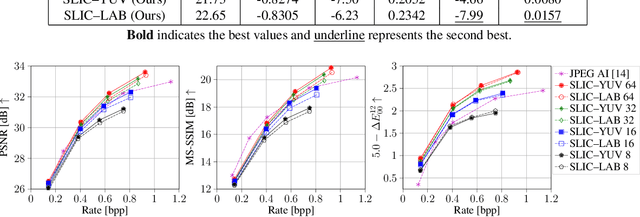A Study on the Effect of Color Spaces in Learned Image Compression
Paper and Code
Jun 19, 2024



In this work, we present a comparison between color spaces namely YUV, LAB, RGB and their effect on learned image compression. For this we use the structure and color based learned image codec (SLIC) from our prior work, which consists of two branches - one for the luminance component (Y or L) and another for chrominance components (UV or AB). However, for the RGB variant we input all 3 channels in a single branch, similar to most learned image codecs operating in RGB. The models are trained for multiple bitrate configurations in each color space. We report the findings from our experiments by evaluating them on various datasets and compare the results to state-of-the-art image codecs. The YUV model performs better than the LAB variant in terms of MS-SSIM with a Bj{\o}ntegaard delta bitrate (BD-BR) gain of 7.5\% using VTM intra-coding mode as the baseline. Whereas the LAB variant has a better performance than YUV model in terms of CIEDE2000 having a BD-BR gain of 8\%. Overall, the RGB variant of SLIC achieves the best performance with a BD-BR gain of 13.14\% in terms of MS-SSIM and a gain of 17.96\% in CIEDE2000 at the cost of a higher model complexity.
 Add to Chrome
Add to Chrome Add to Firefox
Add to Firefox Add to Edge
Add to Edge